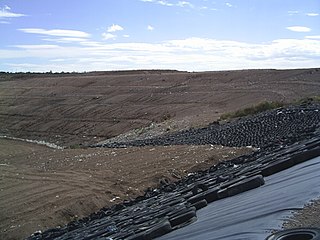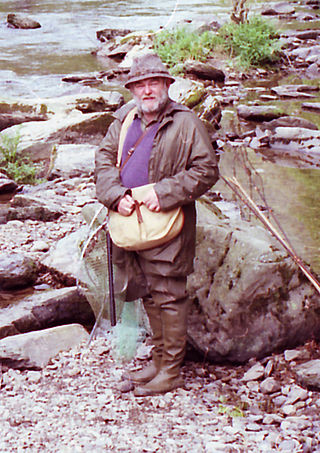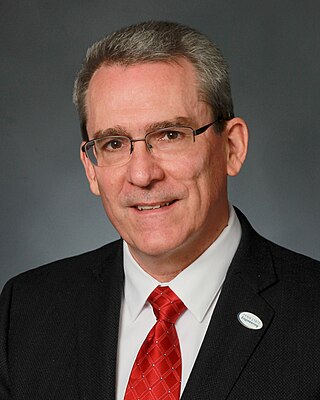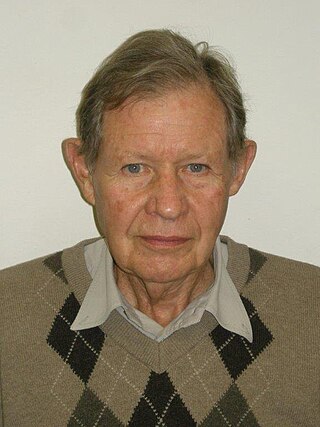
Geosynthetics are synthetic products used to stabilize terrain. They are generally polymeric products used to solve civil engineering problems. This includes eight main product categories: geotextiles, geogrids, geonets, geomembranes, geosynthetic clay liners, geofoam, geocells and geocomposites. The polymeric nature of the products makes them suitable for use in the ground where high levels of durability are required. They can also be used in exposed applications. Geosynthetics are available in a wide range of forms and materials. These products have a wide range of applications and are currently used in many civil, geotechnical, transportation, geoenvironmental, hydraulic, and private development applications including roads, airfields, railroads, embankments, retaining structures, reservoirs, canals, dams, erosion control, sediment control, landfill liners, landfill covers, mining, aquaculture and agriculture.
Robert Ferguson Legget was a civil engineer, historian and non-fiction writer. He is internationally known for his contributions to engineering, geology and building research and standardization. He is credited with the establishment of co-operation among Canadian geotechnical engineers, geologists and pedologists.
A geomembrane is very low permeability synthetic membrane liner or barrier used with any geotechnical engineering related material so as to control fluid migration in a human-made project, structure, or system. Geomembranes are made from relatively thin continuous polymeric sheets, but they can also be made from the impregnation of geotextiles with asphalt, elastomer or polymer sprays, or as multilayered bitumen geocomposites. Continuous polymer sheet geomembranes are, by far, the most common.
Frederick John Longstaffe CM, Ph.D., FRSC is the former Provost and Vice-President (Academic) at The University of Western Ontario. He is a Earth Science researcher. His current focus is on applying knowledge of stable isotopes to various fields of study.

A landfill liner, or composite liner, is intended to be a low permeable barrier, which is laid down under engineered landfill sites. Until it deteriorates, the liner retards migration of leachate, and its toxic constituents, into underlying aquifers or nearby rivers, causing potentially irreversible contamination of the local waterway and its sediments.

Robert James Mair, Baron Mair, is a geotechnical engineer and Emeritus Sir Kirby Laing Professor of Civil Engineering and director of research at the University of Cambridge. He is Head of the Cambridge Centre for Smart Infrastructure and Construction (CSIC). He was Master of Jesus College, Cambridge, from 2001 to 2011 and a fellow of St John's College, Cambridge, from 1998 to 2001. In 2014 he was elected a vice president of the Institution of Civil Engineers and on 1 November 2017 became the Institution's president for 2017–18, its 200th anniversary year. He was appointed an independent crossbencher in the House of Lords in 2015 and is currently a member of its Select Committee on Science and Technology.

Cellular confinement systems (CCS)—also known as geocells—are widely used in construction for erosion control, soil stabilization on flat ground and steep slopes, channel protection, and structural reinforcement for load support and earth retention. Typical cellular confinement systems are geosynthetics made with ultrasonically welded high-density polyethylene (HDPE) strips or novel polymeric alloy (NPA)—and expanded on-site to form a honeycomb-like structure—and filled with sand, soil, rock, gravel or concrete.

Peter Rolfe Vaughan ACGI, DIC, FREng, FICE, FCGI, MASCE, FGS, was Emeritus Professor of Ground Engineering in the Geotechnics department of Imperial College London.

John Boscawen Burland is an Emeritus Professor and Senior Research Investigator at the Department of Civil and Environmental Engineering of Imperial College London.

The Department of Civil and Environmental Engineering is the academic department at Imperial College London dedicated to civil engineering. It is located at the South Kensington Campus in London, along Imperial College Road. The department is currently a part of the college's Faculty of Engineering, which was formed in 2001 when Imperial College restructured. The department has consistently ranked within the top five on the QS World University Rankings in recent years.

Andrew Noel Schofield FRS FREng is a British soil mechanics engineer and an emeritus professor of geotechnical engineering at the University of Cambridge.

Timothy D. Stark is a Professor of Geotechnical Engineering in the Department of Civil and Environmental Engineering at the University of Illinois at Urbana–Champaign since 1991. Dr. Stark teaches undergraduate and graduate courses in Foundation Engineering and Earth Structures, respectively, in the Department of Civil and Environmental Engineering at the UIUC and numerous short courses for various entities. Dr. Stark has served as a consultant and expert on a range of domestic and international projects including levees and dams, buildings, bridges, slopes, geosynthetics, seismic issues, waste containment facilities, and highways. Dr. Stark's current research interests include: (1) Design and performance of Earth Dams, Levees, Floodwalls, Landfills, and other Earth Structures, (2) Behavior of Railroad Track Systems and Transitions, (3) Forensic Geotechnical and Foundation Engineering, (4) Static and Seismic Stability of Natural and Man-Made Slopes, (5) Performance of Compacted Structural Fills and Slopes, and (6) Behavior and Design of Waste Containment Facilities.
Harry George Poulos is an Australian of Greek descent civil engineer specialising in geotechnical engineering and soil mechanics, internationally known as an expert on soil behaviour and pile foundations.

Jean-Pierre Giroud is a French geotechnical engineer and a pioneer of geosynthetics since 1970. In 1977, he coined the words "geotextile" and "geomembrane", thus initiating the "geo-terminology". He is also a past president of the International Geosynthetics Society, member of the US National Academies, and Chevalier de la Légion d'Honneur.
Jorge G. Zornberg is Brunswick-Abernathy Regents Professor in Soil Dynamics and Geotechnical Engineering in the geotechnical engineering program at the University of Texas at Austin. He has over 35 years' experience in geotechnical and geoenvironmental engineering. He is also one of the pioneers of geosynthetics.
David Muir Wood is an academic working in the field of geomechanics and soil mechanics, famous for having pioneered advances in mathematical modelling of soils, informed by experimental observation. The hallmark of his modelling efforts has been to formulate elegant models that capture the essence of the material response while being accessible to practitioners of Geotechnical engineering.

Patrick J Fox, Ph.D., P.E., D.GE, F.ASCE, an American civil engineer, is currently the John A. and Harriette K. Shaw Professor and Head of the Department of Civil and Environmental Engineering at The Pennsylvania State University, a specialist in geotechnical and geoenvironmental engineering. He obtained a Ph.D. in civil and environmental engineering from the University of Wisconsin–Madison in 1992.

The International Geosynthetics Society (IGS) is an engineering professional society focused on the field of geosynthetics, which are polymeric materials used in geotechnical engineering. The IGS describes itself as "a learned society dedicated to the scientific and engineering development of geotextiles, geomembranes, related products, and associated technologies." It was founded in Paris in 1983 as the International Geotextile Society and is a member of the Federation of International Geo-Engineering Societies, along with the International Society of Soil Mechanics and Geotechnical Engineering (ISSMGE), International Society for Rock Mechanics and Rock Engineering (ISRM), and International Association for Engineering Geology and the Environment (IAEG).

Geoffrey Eustace Blight was a professor in the School of Civil Engineering at the University of Witwatersrand (Wits), serving twice as head of department.
J. Stewart Aitchison FRSC is a Scottish scientist and researcher in the area of photonics. Aitchson is known for his work on nonlinear optics. He is professor in the University of Toronto's Electrical and Computer Engineering department. Aitchson was made an IEEE fellow in 2019.












